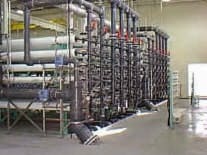End-user's unfamiliarity with membrane elements has been a major obstacle to the technology's widespread adoption. In a bid to positioning ultrafiltration (UF), nanofiltration (NF), and reverse osmosis (RO) as viable and economical solutions to meet the nation's water treatment needs, promotion of membrane technology expects to take top priority for suppliers in this market.
New analysis from Frost & Sullivan, "U.S. Ultrafiltration, Nanofiltration, and Reverse Osmosis Membrane Elements Market," reveals that revenue in this industry totaled $341.3 million in 2004. It's projected to reach $520 million in 2010.
Despite its commercialization since the 1970s, membrane elements' application in large-scale water treatment represents a paradigm shift for end users accustomed to conventional treatment technologies.
Several new and existing government regulations that ensure the safety and quality of public water supply are pushing the case for membrane water and wastewater treatment technology. For example, the Long Term 2 Enhanced Surface Water Treatment Rule (LT2ESWTR) restricts the usage of conventional filtration technologies fail to control pathogen outbreaks efficiently. Such concerns, however, may be addressed effectively by membrane filtration technologies.
"Compared to conventional water treatment, where quality of product water varies with feed water quality, membrane filtration is capable of yielding water of consistent quality regardless of the source," explained Frost & Sullivan research analyst Renee Chu.
The ultrafiltration technology is capable of removing 99.99% of pathogens present in untreated water.
As a specification driven process, membrane filtration provides water of significantly superior quality to meet municipal drinking and wastewater requirements, as well as industrial specifications for water reuse.
Spreading the message to end users regarding the advantages of membrane technology may not suffice, as prices need to be gradually brought in line to those of conventional water treatment options for mass acceptance.
"Fortunately, incremental improvement in membrane quality and product performance has resulted in overall price reduction in membrane water treatment products including membrane elements," said Chu. "This is partly due to advancement in the manufacturing processes such as increased automation, which results in lower production cost."
In addition, with continuous improvement in manufacturing technologies, membrane processes are now more energy efficient, less labor intensive and available in smaller footprints.
Another challenge facing the U.S. membrane elements market is lengthy and costly technological validation requirements currently mandated by the U.S. Environmental Protection Agency (EPA). Validation procedures also vary from state to state, thereby increasing the time-to-market for water treatment products.
Well-established and larger manufacturers that can leverage on their existing competitive advantage are in a better position to profit from opportunities in the membrane technology market.
Besides potable water treatment at the municipal level, membrane technology has penetrated a multitude of industries such as biotechnology and pharmaceutical manufacturing, food and beverages processing, ultra pure water generation for microelectronics, as well as oil and chemicals separation from industrial waste streams.
"To this end, any industry that involves liquid separation or utilizes fluid filters is expected to benefit immensely from the use of membrane technologies," concluded Chu.
"U.S. Ultrafiltration, Nanofiltration, and Reverse Osmosis Membrane Elements Market," part of the Global Water and Wastewater subscription, provides in-depth market analyses of three commonly employed membrane elements in commercial applications. It examines opportunities and challenges that membrane suppliers are likely to encounter in this market. In addition to evaluating total market and technology trends, the study also highlights the competitive strategies adopted by key membrane suppliers.
Source: F&S

